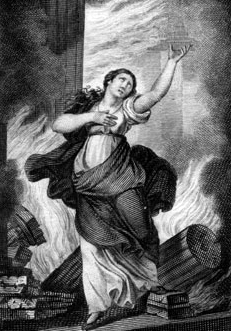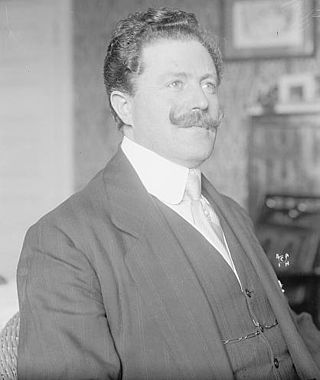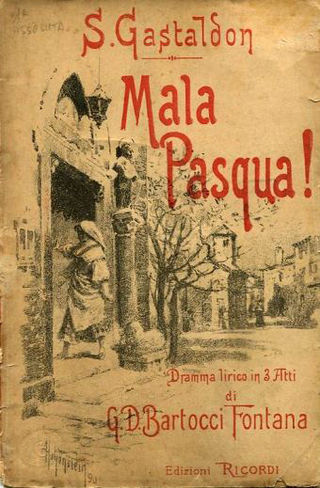
Un ballo in maschera is an 1859 opera in three acts by Giuseppe Verdi. The text, by Antonio Somma, was based on Eugène Scribe's libretto for Daniel Auber's 1833 five act opera, Gustave III, ou Le bal masqué.

The Old Maid and the Thief is a radio opera in one act by Italian-American composer Gian Carlo Menotti. The work uses an English language libretto by the composer which tells a twisted tale of morals and evil womanly power. Menotti writes in the libretto "The devil couldn't do what a woman can- Make a thief out of an honest man."

The Consul is an opera in three acts with music and libretto by Gian Carlo Menotti, his first full-length opera.

Il castello di Kenilworth is a melodramma serio or tragic opera in three acts by Gaetano Donizetti. Andrea Leone Tottola wrote the Italian libretto after Victor Hugo's play Amy Robsart (1828) and Eugène Scribe's play Leicester, both of which following from Sir Walter Scott's novel Kenilworth (1821). Daniel Auber composed another opera on the same subject, Leicester, ou Le chateau de Kenilworth in 1823.

ZazàItalian pronunciation: [dzadˈdza] is an opera by Ruggero Leoncavallo, with a libretto by the composer. The story concerns the French music hall singer, Zazà, and her affair and subsequent decision to leave her lover, Milio, when she discovers that he is married. The music is influenced by the French music halls where Leoncavallo had spent his early years as a composer.

Le duc d'Albe or Il duca d'Alba is an opera in three acts originally composed by Gaetano Donizetti in 1839 to a French language libretto by Eugène Scribe and Charles Duveyrier. Its title, which translates as The Duke of Alba, refers to its protagonist Fernando Álvarez de Toledo, 3rd Duke of Alba. The work was intended for performance at the Paris Opéra. However, William Ashbrook notes that "Rosine Stoltz, the director's mistress, disliked her intended role of Hélène and Donizetti put the work aside when it was half completed".

Le pauvre matelot is a three-act opera composed by Darius Milhaud with libretto by Jean Cocteau. It was given its premiere on 16 December 1927 by the Opéra-Comique at the Salle Favart in Paris. Le pauvre matelot is short, lasting about 35 minutes when performed, and is dedicated to Henri Sauguet. The composer conducted a complete recording with forces of the Paris Opera in 1956. Although Cocteau claimed that the story was inspired by a news item in a paper, the scenario can be found in a 17th-century Franco-Canadian song 'Le Funeste Retour', and the tragedy Der vierundzwanzigste Februar by Werner of 1808.

Medea is an opera in three acts composed by Giovanni Pacini to a libretto by Benedetto Castiglia. It premiered on 28 November 1843 at the Teatro Carolino in Palermo, conducted by the composer with Geltrude Bortolotti in the title role. The libretto is based on the plays Medea by Euripides and Médée by Pierre Corneille.

Didone abbandonata is an opera in three acts composed by Domenico Sarro to a libretto by Pietro Metastasio of the same name which was based on the story of Dido and Aeneas from the fourth book of Virgil's Aeneid. The opera premiered on 1 February 1724 at the Teatro San Bartolomeo in Naples.
Florence Kirk was an American dramatic soprano who had an active international performance career in operas and concerts from 1937 to 1954. Born in Philadelphia and trained at the Curtis Institute of Music by Elisabeth Schumann, she was particularly associated with the roles of Donna Anna in Mozart's Don Giovanni and the title heroine in Verdi's Aida. Her repertoire included other Verdi heroines like Leonora and Lady Macbeth, Santuzza from Mascagni's Cavalleria rusticana, Minnie in Puccini's La fanciulla del West and the title role in Tosca, and several roles from Richard Wagner's Ring Cycle.

Nicola Zerola was an Italian operatic tenor who had an active international career from 1898-1928. He began his career in his native country, but was soon heard in concerts and operas internationally during the first years of the 20th century. In 1908 he relocated to the United States where he was active with important opera companies in New York, Chicago, and Philadelphia up into the late 1920s. Between 1909 and 1911 he recorded 13 issued sides for the Victor Talking Machine Company at their Camden, New Jersey studios. He also made 11 solo recordings and one duet for the Gramophone and Typewriter Company in England in 1910-1911.

Tutti in maschera is an opera by Carlo Pedrotti. The libretto is by Marco Marcelliano Marcello, based on the 1759 comedy L'impresario delle Smirne by Carlo Goldoni. It was premiered at the Teatro Nuovo, Verona, on 4 November 1856.

Mala Pasqua! is an opera in three acts composed by Stanislao Gastaldon to a libretto by Giovanni Domenico Bartocci-Fontana. The libretto is based on Giovanni Verga's play, Cavalleria rusticana which Verga had adapted from his short story of the same name. Mala Pasqua! premiered on 9 April 1890 at the Teatro Costanzi in Rome, six weeks before Pietro Mascagni's opera Cavalleria rusticana which was also based on Verga's play. Bartocci-Fontana's libretto adds some elements that were not in Verga's original and expands on others. The name of the Santuzza character was also changed to Carmela, but the basic plot and setting remain the same. Its title refers to the curse which Carmela places on Turiddu, the lover who had spurned her: "Mala Pasqua a te!". Following its Rome premiere, Mala Pasqua! had a few more performances in Perugia and Lisbon, but it was completely eclipsed by the phenomenal success of Mascagni's opera. After the 1891 Lisbon run it was not heard again until 2010 when it was given a semi-staged performance in Agrigento, Sicily.

The Unicorn, the Gorgon and the Manticore or The Three Sundays of a Poet is a "madrigal fable" for chorus, ten dancers and nine instruments with music and original libretto by Gian Carlo Menotti. Based on the 16th-century Italian madrigal comedy genre, it consists of a prologue and 12 madrigals which tell a continuous story, interspersed with six musical interludes. The unicorn, gorgon, and manticore in the title are allegories for three stages in the life of the story's protagonist, a strange poet who keeps the mythical creatures as pets. The work premiered in Washington D.C. at the Library of Congress Coolidge Auditorium on October 19, 1956.

Alice Zeppilli was a French operatic soprano of Italian heritage who had an active international singing career from 1901 to 1930. The pinnacle of her career was in the United States where she enjoyed great popularity between 1906 and 1914; particularly in the cities of Chicago, New York, and Philadelphia. She was popular in Monte Carlo where she performed frequently from 1904–19 and later worked as a singing teacher after her retirement from the stage. She made only one recording, a phonograph cylinder for Columbia Records consisting of the Gavotte from Jules Massenet's Manon and Olympia's Doll Aria from Jacques Offenbach's The Tales of Hoffmann.

Gloria is a tragic opera in three acts by Francesco Cilea with an Italian libretto by Arturo Colautti. A variation on the Romeo and Juliet story and set in 14th century Siena, the libretto is based on Victorien Sardou's 1874 play La Haine (Hatred). The opera premiered on 15 April 1907 at La Scala conducted by Arturo Toscanini with Solomiya Krushelnytska in the title role. Gloria was a failure at its premiere when it was withdrawn after two performances and fared little better in the 1932 revised version, although there have been two late 20th century revivals. It proved to be Cilea's last staged opera. In the 43 years following the premiere of Gloria he worked on two or three further operas which were never performed and continued to compose chamber and orchestral music.

Gian Carlo Menotti was an Italian composer, librettist, director, and playwright who is primarily known for his output of 25 operas. Although he often referred to himself as an American composer, he kept his Italian citizenship. One of the most frequently performed opera composers of the 20th century, his most successful works were written in the 1940s and 1950s. Highly influenced by Giacomo Puccini and Modest Mussorgsky, Menotti further developed the verismo tradition of opera in the post-World War II era. Rejecting atonality and the aesthetic of the Second Viennese School, Menotti's music is characterized by expressive lyricism which carefully sets language to natural rhythms in ways that highlight textual meaning and underscore dramatic intent.

Abigaille Bruschi-Chiatti was an Italian soprano who sang in the principal opera houses of Italy as well as in Latin America and at the Teatro Real in Spain. Amongst the roles she created were Amelia di Egmont in the 1882 posthumous premiere of Donizetti's Il duca d'Alba and Élisabeth de Valois in the 1884 revised version of Verdi's Don Carlos.
Maria Cecilia Fusco was an Italian operatic soprano and voice teacher. In a long career, she appeared regularly at La Scala in Milan, and leading opera houses in Italy and abroad. Her broad repertoire included works from early Italian opera to premieres of contemporary opera.















